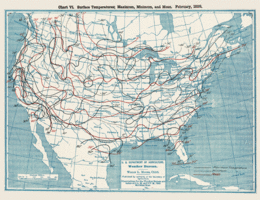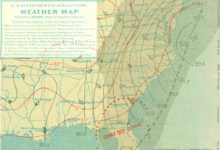Great Blizzard of 1899
 Snowball fight on the steps of the Florida State Capitol in Tallahassee in February 1899 | |
| Type | Winter storm and historic cold wave |
|---|---|
| Formed | February 10, 1899[1] |
| Dissipated | February 14, 1899 |
| Fatalities | Over 100 deaths[2] |
| Areas affected | United States, particularly east of the Rocky Mountains |
The Great Blizzard of 1899, also known as the Great Arctic Outbreak of 1899 and the St. Valentine's Day Blizzard, was an exceptionally severe winter weather event that affected most of the United States, particularly east of the Rocky Mountains. On February 11, Swift Current in present-day Saskatchewan reported a record-high barometric pressure of 31.42 inches of mercury (1,064 mb). While there was heavy snow during this event, the 1899 storm was most noted for the record cold it brought to several areas of the USA, including the first (and only) below 0 °F (−17.8 °C) temperature ever recorded in Florida, when the state capital Tallahassee in the extreme northern Panhandle recorded −2 °F or −18.9 °C. [3]: 1
Temperatures and records
[edit]
Based on the 1895 to 2024 period of record:
- February 1899 was the second-coldest February in the contiguous U.S. behind only 1936. The average temperature was 25.50 °F (−3.61 °C), which was 8.36 °F (4.64 °C) colder than the 1895-2024 average of 33.86 °F (1.03 °C) and 0.27 °F (0.15 °C) warmer than February 1936.[4]
- December 1898 through February 1899 was the third-coldest meteorological winter in the contiguous U.S. (behind the coldest and second-coldest winters of 1978/79 and 1935/36, respectively). The average temperature was 27.95 °F (−2.25 °C), which was 4.47 °F (2.48 °C) colder than the 1895-2017 average of 32.42 °F (0.23 °C) and 1.34 °F (0.74 °C) warmer than the 1978/79 winter.[5]
- November 1898 through March 1899 was the coldest November to March period on record in the contiguous U.S. The average temperature was 31.97 °F (−0.02 °C), which was 4.22 °F (2.34 °C) colder than the 1895-2017 average of 36.19 °F (2.33 °C), 0.24 °F (0.13 °C) colder than the second-coldest November to March of 1911/12, and 0.71 °F (0.39 °C) colder than the third-coldest from November 1978 to March 1979.[6]
- February 1899 was the coldest February in Kansas, Missouri, and Wyoming.[7]
- February 1899 was the second-coldest February in Arkansas, Colorado, Mississippi, Montana, Nebraska, Oklahoma, and South Dakota.[8]
Winter weather
[edit]
On February 12, snow flurries were observed in the air (briefly) in a few areas from New Orleans eastward to Tampa.[1] The storm crossed the Florida peninsula with rain and wind, then intensified as it moved rapidly up the east coast.[2] High Point, North Carolina, recorded 10–12 inches (25–30 cm) of snow.[3] Washington, D. C. recorded a single-day snowfall of 20.5 inches (52 cm), which was a record for the time. (On January 28, 1772, 36 inches (91 cm) of snow fell in the Washington area during the "Washington and Jefferson Snowstorm"; however that was before official record-keeping began.[9])
On February 19, ice floes were reported to be moving out of the Mississippi River into the Gulf of Mexico.[3]: 48 On February 14, New Orleans dropped to 6 °F (−14.4 °C), an all-time record.[10] The previous day, the city experienced its coldest-ever Mardi Gras with a minimum of 7 °F (−13.9 °C). [11][12]
The low temperature in Miami, Florida, on February 14 dropped to 29 °F (−1.7 °C) with a high of only 48 °F (8.9 °C). The city has only recorded a lower temperature twice since record-keeping commenced on September 6, 1895.[13]
The low temperature in Tallahassee, Florida dropped to −2 °F (−18.9 °C) on February 13, 1899 with a record low maximum of 22 °F (−5.6 °C) on the 14th. This is the only time to this day that sub-0 °F (−17.8 °C) temperatures have ever been recorded in Florida.
Casualties, damages and inconveniences
[edit]The Great Arctic Outbreak of 1899 had disastrous impact across many areas of the continental U.S. and Cuba as people, livestock, and wildlife succumbed to the frigid cold.
Bird populations were decimated across the nation. Henderson County, Tennessee saw nearly the complete extinction of its bluebird population[14] and Culpeper County, as well as most northern and central Virginia counties lost nearly all of its quail, having to import new birds in the late teens and 1920s to repopulate the areas.[15]
Some of the bird species affected:[16] Bluebird, Blue-headed vireo, Catbirds, Chipping sparrow, Dark-eyed junco (also known as snowbird), Fox sparrow, Grass finch, Hermit thrush, Killdeer, Meadowlark, Mourning dove, Pine warbler, Quail, Savannah sparrow, Song sparrow, Swamp sparrow, and Woodcock.
It has been estimated that over 100 people died.[2] In Brooklyn, 31 year-old Mary Goodwin was frozen to death and a thinly clad, unidentified woman in The Dalles, Oregon, was found frozen to death in a hallway in an attempt to find warmth. Mail carriers Palmer and Hawkins of New York were thought to have drowned attempting to deliver the mail. It is believed that their boat, overturned by the high winds, was crushed by the floating ice.[17]
Crops were ruined, and orchards utterly destroyed in Georgia.[18] Walla Walla, Washington's majority of wheat was destroyed by the frost with Eureka Flat seeing the most damage.[19]
Traffic was brought to a complete standstill in all parts of the country. Barges on the Mississippi River — which was in some parts entirely frozen through — and the Great Lakes, were brought to a complete standstill. Traffic across all railroads were delayed or paralyzed indefinitely while steamers and liners were likewise delayed.[20]
See also
[edit]- Great Freeze
- 1985 North American cold wave
- 1993 Storm of the Century
- 1994 North American cold wave
- Early 2014 North American cold wave
- February 2015 North American cold wave
- February 2021 North American cold wave
- December 2022 North American winter storm
References
[edit]- ^ Melissa Griffin (February 11, 2015). "The Great Blizzard of 1899". WeatherSTEM. Archived from the original on October 6, 2016. Retrieved September 14, 2016.
- ^ a b "Climate History: The Great Arctic Outbreak of February 1899". National Climatic Data Cente. Archived from the original on April 18, 2022. Retrieved September 15, 2016.
- ^ a b "Forecasts and Warnings" (PDF). Monthly Weather Review. February 1899. Archived (PDF) from the original on August 1, 2017. Retrieved December 27, 2017.
- ^ "February, Average temperature, Contiguous U.S." National Oceanic and Atmospheric Administration. Retrieved May 9, 2024.
- ^ "December through February, Average temperature, Contiguous U.S." National Centers for Environmental Information. Retrieved May 9, 2024.
- ^ "Contiguous U.S. Average Temperature: November to March". National Oceanic and Atmospheric Administration. Retrieved May 9, 2024.
- ^ "February, Average temperature, Kansas, Missouri, Wyoming (statewide)". National Centers for Environmental Information. Archived from the original on January 3, 2018. Retrieved January 2, 2018.
- ^ "February, Average temperature, Arkansas, Colorado, Mississippi, Montana, Nebraska, Oklahoma, South Dakota (statewide)". National Centers for Environmental Information. Archived from the original on January 3, 2018. Retrieved January 16, 2018.
- ^ National Weather Service, Mid Atlantic Winters – SNOW, WIND, ICE, AND COLD Archived November 13, 2015, at the Wayback Machine
- ^ "Arctic Outbreaks to Affect Southeast Louisiana and Southern Mississippi (1886 - Present)". National Weather Service Forecast Office, New Orleans/Baton Rouge, LA. Archived from the original on July 15, 2022. Retrieved July 15, 2022.
- ^ "2013 Mardi Gras Climatology". National Weather Service. January 6, 2013. Archived from the original on April 13, 2014. Retrieved February 6, 2010.
- ^ "Weather Service Marks Centennial of Benchmark Cold Wave". NOAA News. February 9, 1999. Archived from the original on February 17, 2013. Retrieved March 27, 2013.
- ^ "NOAA Online Weather: Lowest Min Temperature by Day for Miami Area, FL". National Weather Service Forecast Office, Miami-South Florida, FL. Archived from the original on November 12, 2018. Retrieved December 27, 2017.
- ^ Coggins, Allen, R. (2012). Tennessee Tragedies: Natural, Technological, and Societal Disasters in the Volunteer State. Knoxville: University of Tennessee Press. p. 80. ISBN 9781572338418.
{{cite book}}: CS1 maint: multiple names: authors list (link) - ^ Johnston, Donnie (January 3, 2011). "Culpeper Part of State Plan to Restore Quail". The Free Lance-Star. Archived from the original on August 1, 2020. Retrieved November 6, 2017.
- ^ Wayne, Arthur T. (April 1899). "Destruction of Birds by the Great Cold Wave of February 13 and 14, 1899". The Auk. 16 (2): 197–198. doi:10.2307/4069575. JSTOR 4069575. Archived from the original on February 13, 2023. Retrieved August 10, 2020.
- ^ "Severe Storm". Daily Capital Journal. February 13, 1899. Archived from the original on November 7, 2017. Retrieved November 6, 2017.
- ^ "More Slides Feared". The Dalles Daily Chronicle. February 14, 1899. Archived from the original on November 7, 2017. Retrieved November 6, 2017.
- ^ "Wheat Badly Damaged". The Dalles Daily Chronicle. February 14, 1899. Archived from the original on November 7, 2017. Retrieved November 6, 2017.
- ^ "Terrible Havoc By Blizzards". The Dalles Daily Chronicle. February 14, 1899. Archived from the original on November 7, 2017. Retrieved November 6, 2017.
